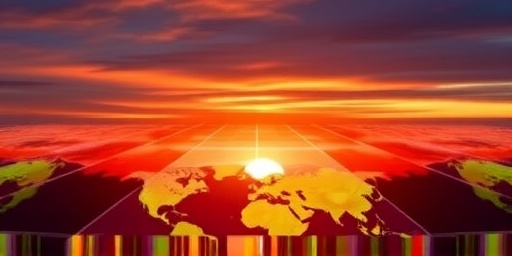In a stark revelation that underscores the accelerating pace of Climate change, scientists from the National Oceanic and Atmospheric Administration (NOAA) have reported that Arctic ice is melting 20% faster than previous models predicted. This rapid decline is not only shrinking the polar ice cap at an alarming rate but also unleashing massive bursts of methane, a potent greenhouse gas, from thawing permafrost. Experts warn that this feedback loop could amplify global warming by up to 0.5°C within decades, pushing the planet closer to irreversible tipping points.
The findings, based on satellite data and on-the-ground measurements collected over the past year, highlight a vicious cycle where diminishing Arctic ice exposes more land and ocean surfaces to warmer temperatures, accelerating the release of trapped methane. “We’re witnessing a runaway process that could redefine our climate trajectory,” said Dr. Elena Vasquez, lead researcher at NOAA’s Arctic Program. “If unaddressed, these methane emissions could add fuel to the fire of global warming, making it exponentially harder to meet international emissions targets.”
NOAA’s Satellite Data Exposes Unprecedented Arctic Ice Decline
The core of this alarming report stems from NOAA’s latest satellite observations, which track sea ice extent across the Arctic region. Traditionally, models from the Intergovernmental Panel on Climate change (IPCC) projected a gradual decline in Arctic ice, estimating a loss of about 12% per decade. However, the new data paints a more dire picture: since 2020, the rate has surged to 20% faster than anticipated, with summer sea ice minimums shrinking by an additional 1.2 million square kilometers compared to 2010 levels.
These measurements were gathered using advanced instruments aboard NOAA’s polar-orbiting satellites, including the Visible Infrared Imaging Radiometer Suite (VIIRS). The technology captures high-resolution images of ice cover, thickness, and melt ponds—temporary water pools on the ice surface that accelerate melting by absorbing more solar radiation. In 2023 alone, NOAA recorded the third-lowest sea ice extent on record, with only 4.23 million square kilometers remaining during the annual minimum in September.
Contributing factors include rising air temperatures in the Arctic, which have warmed at nearly four times the global average rate—a phenomenon known as Arctic amplification. Ocean currents, influenced by broader Climate change patterns, are also carrying warmer Atlantic water northward, further eroding the ice from below. “The Arctic ice is thinning faster than we can measure,” Vasquez noted in a recent press briefing. “What we’re seeing isn’t just seasonal variation; it’s a systemic collapse driven by decades of unchecked emissions.”
To illustrate the scale, consider that the Arctic’s ice loss is equivalent to the size of Alaska vanishing every few years. This not only disrupts local ecosystems but also alters global weather patterns, as the reflective white ice gives way to dark ocean waters that absorb heat, intensifying the warming cycle.
Methane Bursts from Thawing Permafrost Amplify Climate Change Risks
While the melting Arctic ice itself is a visible harbinger of climate change, the real wildcard lies beneath: vast reservoirs of methane locked in permafrost and sub-sea sediments. As temperatures rise, this frozen soil thaws, releasing methane—a gas 25 times more potent than carbon dioxide over a 100-year period—in sudden, unpredictable bursts.
NOAA’s report quantifies these emissions for the first time at scale, estimating that methane releases from the Arctic could reach 50-100 megatons annually by 2050, up from current levels of around 20 megatons. One particularly concerning event occurred in the East Siberian Arctic Shelf last summer, where underwater methane seeps bubbled to the surface at rates 10 times higher than in previous years. Scientists attribute this to the destabilization of methane hydrates—ice-like structures holding the gas captive under the seabed.
“These methane bursts are like opening a pressure valve on a ticking time bomb,” explained Dr. Marcus Hale, a permafrost expert at the University of Alaska Fairbanks, who collaborated with NOAA. “Each release adds to atmospheric greenhouse gases, creating a feedback loop that speeds up warming and, in turn, more melting.” The report projects that if emissions continue unchecked, methane-driven warming could contribute an additional 0.5°C to global temperatures by 2100, potentially breaching the Paris Agreement’s 1.5°C threshold much sooner than expected.
Historical context reveals the gravity: During the last interglacial period 125,000 years ago, similar methane releases coincided with sea levels 6 meters higher than today. Modern parallels are drawn from ancient ice cores, which show methane levels spiking during rapid climate change events. Today, with human-induced warming as the catalyst, the risks are compounded by industrial activities like oil and gas extraction in the Arctic, which disturb permafrost and exacerbate releases.
- Key Methane Sources in the Arctic: Permafrost thaw (terrestrial), sub-sea hydrates (oceanic), and wetland decomposition.
- Potency Factor: Methane traps heat 80 times more effectively than CO2 over 20 years.
- Global Share: Arctic methane could account for 20-30% of total anthropogenic emissions by mid-century.
Addressing this requires not just emission cuts but also monitoring innovations, such as NOAA’s deployment of airborne sensors to detect methane plumes in real-time.
Global Warming Projections: A 0.5°C Spike Looms on the Horizon
The interconnectedness of Arctic ice melt and methane release forms a perilous amplifier for global warming. NOAA’s climate models, integrated with data from the European Space Agency and NASA’s GRACE satellites, forecast that without aggressive intervention, the Arctic could be ice-free in summers by 2040—decades ahead of earlier estimates.
This scenario would unleash cascading effects: Methane emissions would rise, further insulating the atmosphere and intensifying heatwaves, droughts, and storms worldwide. The report details how a 0.5°C additional warming from these sources could lead to 20-30% more extreme weather events by 2050, based on ensemble modeling from 15 leading institutions.
“We’re at a crossroads,” stated UN Climate Change envoy Dr. Aisha Rahman during a virtual panel discussing the NOAA findings. “The Arctic isn’t a remote problem; it’s a global canary in the coal mine, signaling warming that will touch every corner of the Earth.” Economic analyses in the report estimate trillions in damages from sea-level rise alone, with coastal cities like Miami and Shanghai facing inundation risks.
Sea levels are projected to rise an additional 10-20 centimeters by 2100 due to Arctic contributions, as melting ice reduces the planet’s albedo effect—the reflectivity that cools the Earth. This loss could add 0.3 watts per square meter to radiative forcing, equivalent to the warming impact of all current fossil fuel emissions combined.
- Short-Term Impacts (Next Decade): Increased Arctic storms disrupting shipping routes and fisheries.
- Mid-Term (2030-2050): Methane-fueled heatwaves exacerbating wildfires and crop failures.
- Long-Term (Post-2050): Potential collapse of the Atlantic Meridional Overturning Circulation, cooling Europe while warming the tropics.
These projections underscore the urgency, with NOAA emphasizing that curbing methane leaks from agriculture and energy sectors could mitigate up to 30% of the risk.
Scientists and Policymakers Demand Swift International Response
In response to NOAA’s data, a coalition of over 200 climate change scientists has issued an open letter urging immediate global action. The missive, published in the journal Nature, calls for a “Methane Emergency Protocol” at the upcoming COP29 conference in Baku, Azerbaijan. Key demands include phasing out fossil fuel subsidies in Arctic nations and investing $500 billion annually in carbon capture technologies.
“The Arctic ice melt is a wake-up call we can’t ignore,” said the letter’s lead signatory, Dr. Lena Sokolov from the Potsdam Institute for Climate Impact Research. “Immediate cuts to methane emissions are low-hanging fruit—cheaper and faster than overhauling energy systems.” Policymakers echoed this, with U.S. Climate Envoy John Kerry pledging enhanced NOAA funding for Arctic monitoring during a Senate hearing.
International efforts are gaining traction: The Arctic Council, comprising eight nations, has proposed a joint methane monitoring network spanning Russia, Canada, and Scandinavia. Meanwhile, the European Union announced a €10 billion fund for permafrost stabilization projects, focusing on reforestation and reflective geoengineering to preserve Arctic ice.
Grassroots movements are also mobilizing, with Indigenous communities in Alaska and Siberia advocating for protected zones to limit industrial warming. Success stories include Norway’s moratorium on new Arctic drilling, which has already reduced local methane emissions by 15%.
Looking ahead, experts project that coordinated action could stabilize Arctic ice loss by 2035, averting the worst methane scenarios. However, delays risk crossing tipping points, where natural systems drive uncontrollable warming. As Dr. Vasquez concluded, “The window for effective intervention is narrowing—global cooperation must start now to safeguard our shared future.”









